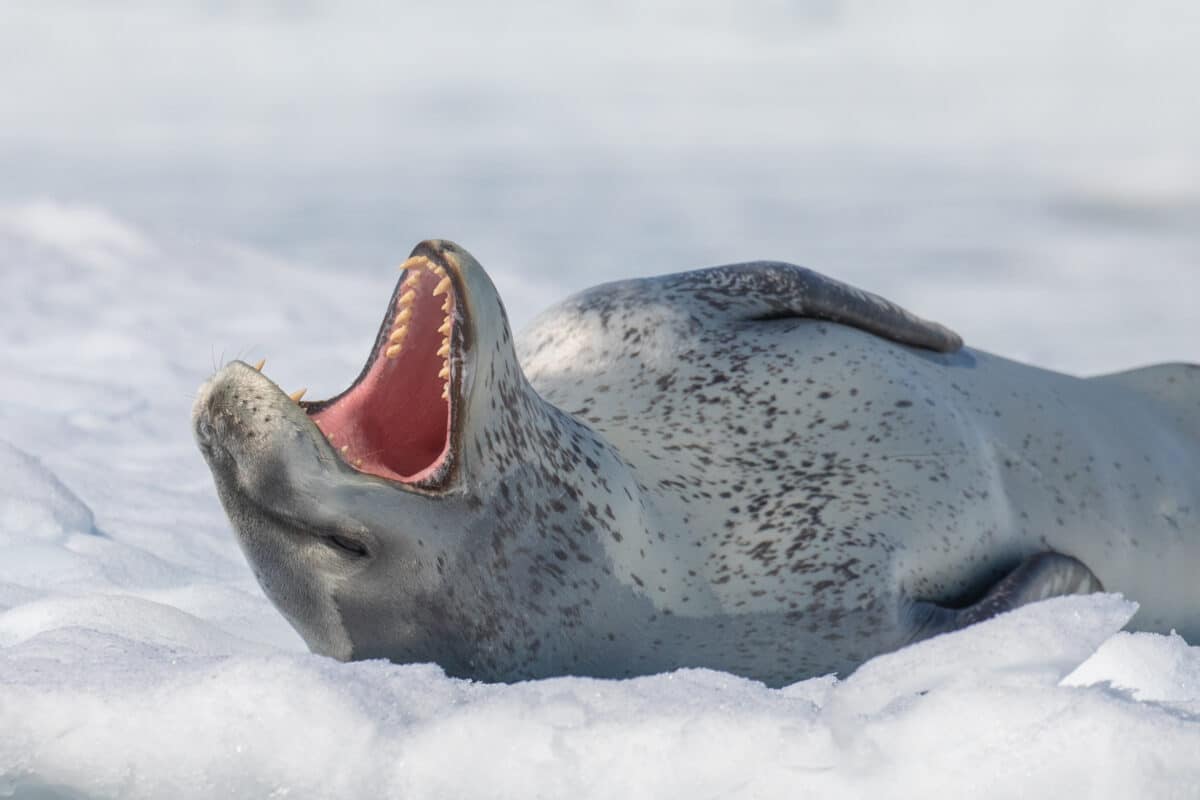Leopard seal opens it mouth for a photograph while laying out on the ice. (Photo by Tarpan on Shutterstock)
In A Nutshell
- Male leopard seals sing underwater during mating season, producing complex sequences using five distinct call types.
- Their songs show statistical patterns that are more structured than random noise but more random than nursery rhymes.
- Compared to other animals, the seals’ songs are less predictable than humpback whale songs but more organized than dolphin and monkey vocalizations.
- The vocal sequences are consistent across days, suggesting the songs may help identify individual seals across vast Antarctic distances.
SYDNEY — Beneath Antarctic ice, one of the ocean’s most fearsome predators is belting out underwater ballads that follow recognizable patterns, and scientists say they carry a statistical structure not unlike a nursery rhyme. Male leopard seals, solitary marine mammals known for hunting penguins, spend hours each day during breeding season performing elaborate vocal sequences that show more order than randomness.
New research published in Scientific Reports shows that these apex predators create underwater vocalizations with statistical patterns that are comparable to nursery rhymes in their predictability, but with more randomness. Scientists analyzed songs from 26 male leopard seals in Eastern Antarctica and found that their vocalizations are more structured than random noise, but less constrained than many forms of human music.
As the University of New South Wales researchers write, “The estimated information entropy of the leopard seal songs is comparable to nursery rhymes but unsurprisingly, lower than contemporary, classical and baroque music.”


How Do Leopard Seals Create Their Underwater Songs?
Leopard seals perform their songs using five distinct call types: high double trills, medium single trills, low descending trills, low double trills, and a hoot with a low single trill. Males arrange these into long underwater sequences, surfacing briefly to breathe before diving back down to continue their vocal routines.
“They’re like the songbirds of the Southern Ocean,” study co-author Tracey Rogers says in a statement. “During the breeding season, if you drop a hydrophone into the water anywhere in the region, you’ll hear them singing.”
To assess how structured these sequences are, the researchers used a mathematical tool called information entropy. In simple terms, a completely random sequence has high entropy, while a more predictable sequence has lower entropy.
Recordings from 1992 to 1998 revealed that leopard seal songs aren’t just random collections of sounds. Knowing one call made it statistically more likely to predict the next, though the songs were still more random than nursery rhymes.
How Do Leopard Seal Songs Compare to Other Animal Communication?
Compared to other animals, leopard seal vocalizations occupy a middle ground of complexity. The study found that their songs have less predictable temporal structure than those of humpback whales and bottlenose dolphins, including dolphin whistle sequences. Entropy estimates for squirrel monkeys were similar to those of leopard seals, suggesting comparable levels of vocal complexity, though the paper does not state a clear hierarchy between them. Importantly, all of these animal vocalizations were far more structured than random sequences, indicating meaningful patterning in how sounds are arranged.
Compared to human music, leopard seal songs were more predictable than compositions by the Beatles and far more so than classical works by composers like Bach or Mozart, which exhibit much higher variation and entropy. The seals’ vocalizations were statistically comparable to simple nursery rhymes, though slightly more random.
This distribution of vocal complexity appears to reflect the biological needs of each species. For leopard seals, which remain solitary and widely dispersed during mating season, structured songs may help individuals identify each other across long distances.
“The greater structure in their songs helps ensure that distant listeners can accurately receive the message and identify who is singing,” explains lead author Lucinda Chambers. “It’s like they’re saying, ‘I’m the biggest and the strongest, look how long and how loud I can sing’.”
Why Do Leopard Seals Use Predictable Song Patterns?
The study found that individual males repeat signature vocal patterns with strong consistency. According to the paper, “Individual leopard seals were observed to retain their particular sequences over three days which suggests that the sequences are stable and could encode information about the singer’s identity.”
Singing also demands significant energy. “Larger males maintain a more consistent call rate that does not vary throughout the breeding season,” the paper notes, while smaller seals often reduce their singing over time, likely due to fatigue.
The researchers conclude: “The greater structure of the leopard seal’s song improves the ability of distant listeners to accurately receive signals and identify singers, which is essential for this widely dispersed species”.
This study is part of a growing effort to understand how animals encode and transmit information. Rather than focusing on what the sounds mean, researchers used statistical methods to study how the sequences are built.
While leopard seal songs aren’t as tightly structured as human compositions or whale songs, they’re clearly not random. Their structure likely evolved to help communicate identity or fitness across the vast icy expanses of Antarctica, suggesting even solitary predators rely on remarkably intricate signals.
Paper Summary
Methodology
Researchers recorded leopard seal vocalizations in the Davis Sea, Eastern Antarctica, between 1992-1998 during the breeding season (November-January). They analyzed songs from 26 individual male seals, converting the acoustic sequences into symbolic codes using five distinct call types. The team applied information entropy analysis using three different mathematical models: independent and identically distributed (i.i.d.), first-order Markov models, and sliding window match length (SWML) estimation. They compared the entropy values to other animal communications and human music to determine relative complexity and predictability.
Results
Leopard seal songs showed entropy estimates ranging from 0.63-2.38 bits, with values comparable to nursery rhymes but lower than classical music. All songs demonstrated more sequential structure than random sequences, with knowing previous calls helping predict subsequent ones. However, 21 of 26 seals showed patterns too complex for simple first-order Markov models to fully capture. The songs were more predictable than contemporary classical music but less predictable than humpback whale songs, suggesting intermediate complexity in animal communication systems.
Limitations
The study used recordings from a single geographic region and time period (1990s), limiting generalizability across leopard seal populations. Sample sizes for some analyses were constrained by the need for sufficient sequence length. The SWML entropy estimator contained positive bias that couldn’t be analytically corrected. Comparisons with other species were limited by different methodological approaches and sample sizes in previous studies. The biological meaning of the statistical patterns remains unknown.
Funding and Disclosures
The authors declared no competing interests and stated no financial conflicts that could influence the research objectivity. No specific funding sources were mentioned in the paper. The study was conducted by researchers from the University of New South Wales Sydney, Australia, and the University of Massachusetts Dartmouth, USA.
Publication Information
“Leopard seal song patterns have similar predictability to nursery rhymes” by Lucinda E. H. Chambers, John R. Buck, and Tracey L. Rogers was published in Scientific Reports (2025), volume 15, article number 26099. The paper is available under Creative Commons Attribution-NonCommercial-NoDerivatives 4.0 International License. DOI: https://doi.org/10.1038/s41598-025-11008-8.
